Maryville Avenue, Belfast, Flood Alleviation Project (2021)
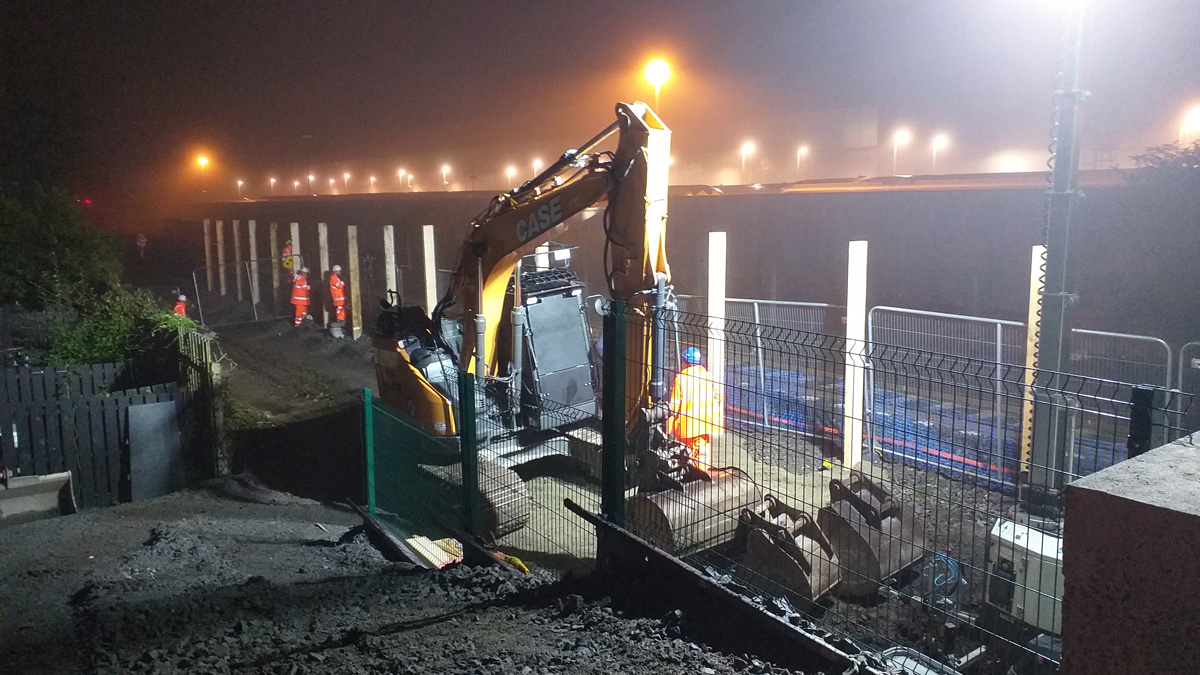
Activities adjacent to rail line carried out at night - Courtesy of AG Wilson
Customers’ residential properties on Maryville Avenue, South Belfast, had experienced out-of-sewer flooding during periods of heavy rainfall due to the poor condition of the sewerage infrastructure and the partial collapse of a 375mm diameter combined sewer. This sewer is located within 5m of the Belfast to Dublin high-speed rail line and in close proximity to approximately 80 residential properties. Therefore, any construction work is very difficult due to the restricted working space. As part of the on-going capital works flood alleviation programme, NI Water invested £1.1m to reduce the risk of out-of-sewer flooding.
Appraisal
Atkins undertook an appraisal to assess the cause of flooding and to identify any properties at risk of internal flooding. A localised 2D mesh was added to the model at Maryville Avenue to simulate overland flow due to flooding from manholes. The model was used to simulate a 1 in 20-year return period storm. Results predicted out-of-sewer flooding from two manholes on Maryville Avenue due to insufficient capacity in the combined sewer network. The extent of predicted flooding is shown in the diagram below and corresponded with customer complaints received by NI Water. It confirmed that seven residential properties were at risk of internal flooding during a 1 in 20-year return period storm.
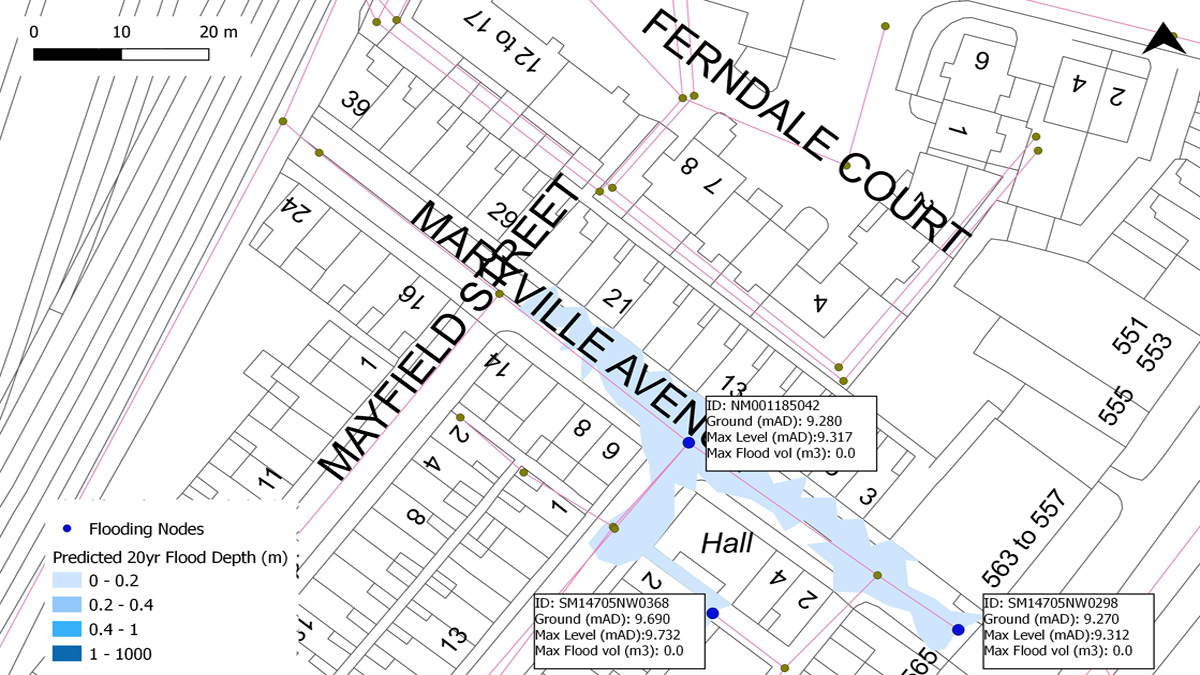
Predicted flooding locations from model
Solution development
Site investigations identified the size and condition of the existing 375mm combined sewer as being the principal cause of flooding. The proposed solution was to replace 85m of the existing sewer with a new 600mm concrete sewer. However, this would be difficult as the sewer was located within a very narrow strip of land sandwiched between the Belfast to Dublin rail line and the rear of residential apartments with limited construction access.
Early consultations with the rail authority identified that any significant excavation work would be limited to a 4 to 5-hour window at night.
Open-cut replacement would require sheet piling to the sides of the entire excavation to protect the rail line, but this was ruled out due to the prolonged night-time noise impact to residents. Therefore, a micro-tunnelling solution using a tunnel boring machine (TBM) was developed. A temporary access ramp would be required and hoarding would be erected alongside the railway to allow the contractor to work more freely with only the pit construction and crane lifts restricted to night-time working. The tunnelling could proceed during normal working hours with regular track monitoring in place.
Temporary works design was carried out by MEA Consultants, with design drawings and calculations approved by Translink.
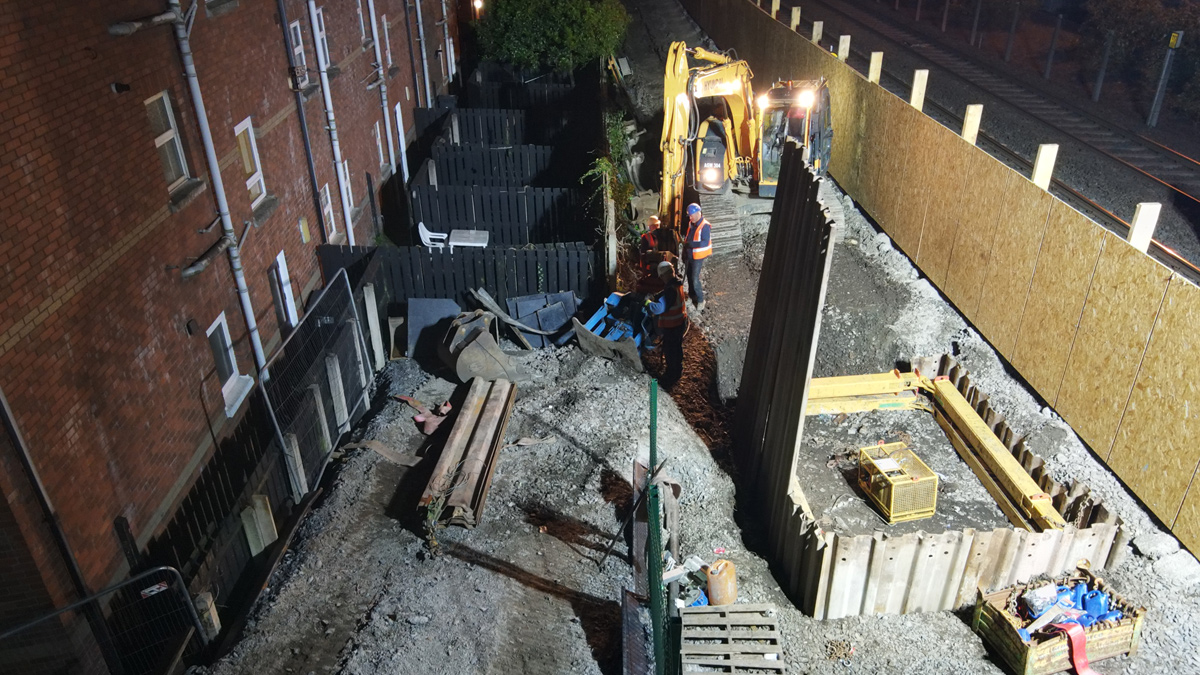
Restricted working area between rail line and private properties – Courtesy of AG Wilson
Construction
AG Wilson was appointed through NI Water’s IF019 Small Sewers Minor Works Framework to deliver the solution. B&W Tunnelling Ltd was sub-contracted for the tunnelling work.
The first action was to set up a safe working area with access for plant, equipment and operatives. A timber hoarding was erected at a distance of 2.1m from the rail line which provided safe separation between the work site and rail corridor. Site set-up could only take place outside train operating hours. The launch pit and reception pit were then constructed in accordance with the temporary works design. Sheet piles were driven to a depth of 4.5m. The piling operation was limited to night-time hours, which generated several noise and vibration related complaints from local residents. Trigger levels were set to detect movement of the pit struts and adjacent rail track. A 5mm alarm level was set, which if exceeded would lead to cessation of work. Monitoring points were set up along the rail track at 1m intervals and checked every four hours.
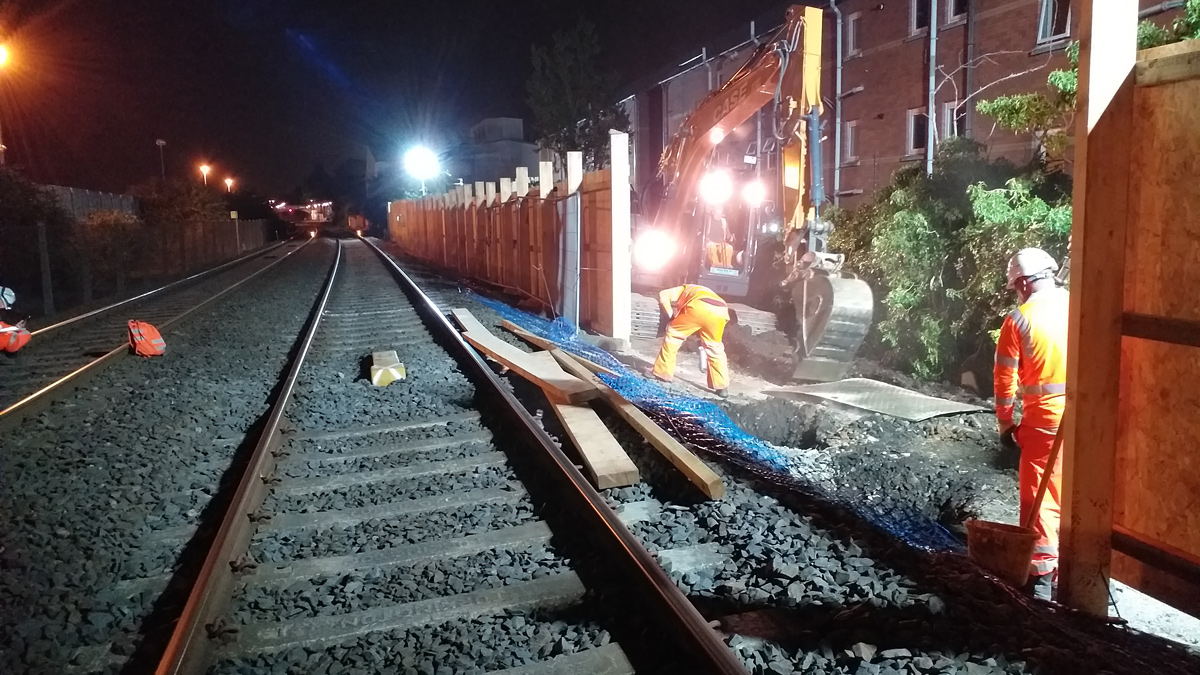
Timber hoarding providing safe separation between work site and rail line – Courtesy of AG Wilson
The combined sewer remained live throughout the construction stage, so flow had to be managed to ensure the already fragile pipe did not crack during sheet piling and tunnelling operations. Over-pumping was carried out at Great Northern Street to ensure the flow within the existing pipe was kept to a minimum.
A crane was utilised to lift the tunnelling equipment onto site. The approved crane lifting plan required the lift to take place during the night and a slew restrictor was used to ensure that the adjacent Adelaide Depot was not affected. The separator, generator and skip were located, with agreement, in an adjacent M&S yard, with the launch frame, TBM and control cabin lowered onto the site adjacent to the rail line.
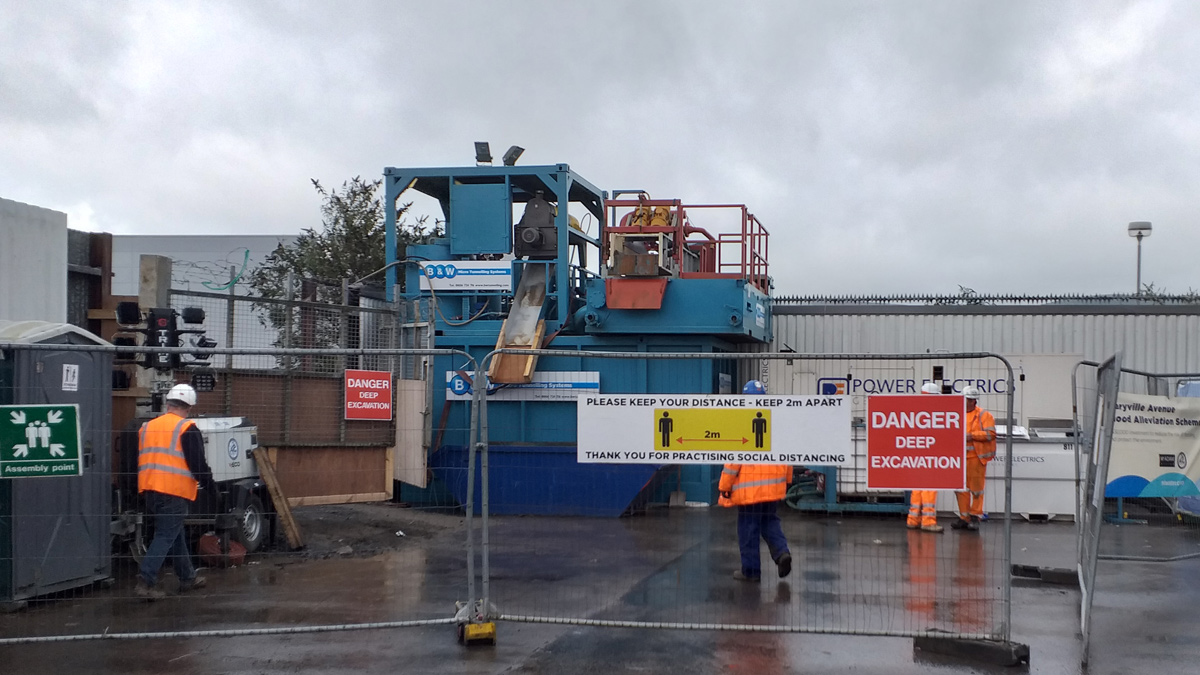
Tunnelling equipment located in M&S delivery yard – Courtesy of AG Wilson
Prior to launch of the TBM, B&W Tunnelling Ltd spent three days connecting up the control cabin and preparing the launch frame. With AG Wilson responsible for setting up the TBM alignment, Clifford and Gregg Surveyors were engaged to provide the alignment between the launch and reception pits. Tight tolerances meant that TBM navigation had to be accurate, with only a 100mm tolerance at the reception pit. The laser was checked on a daily basis by B&W and AG Wilson so ensure the target was still being met. Clifford and Gregg carried out further checks at surface-level, at the mid-point of the drive.
The first 60m of tunnelling was relatively straight forward, with ground conditions primarily consisting of soft clay. This caused a few blockages at the separator, but no major issues were encountered.
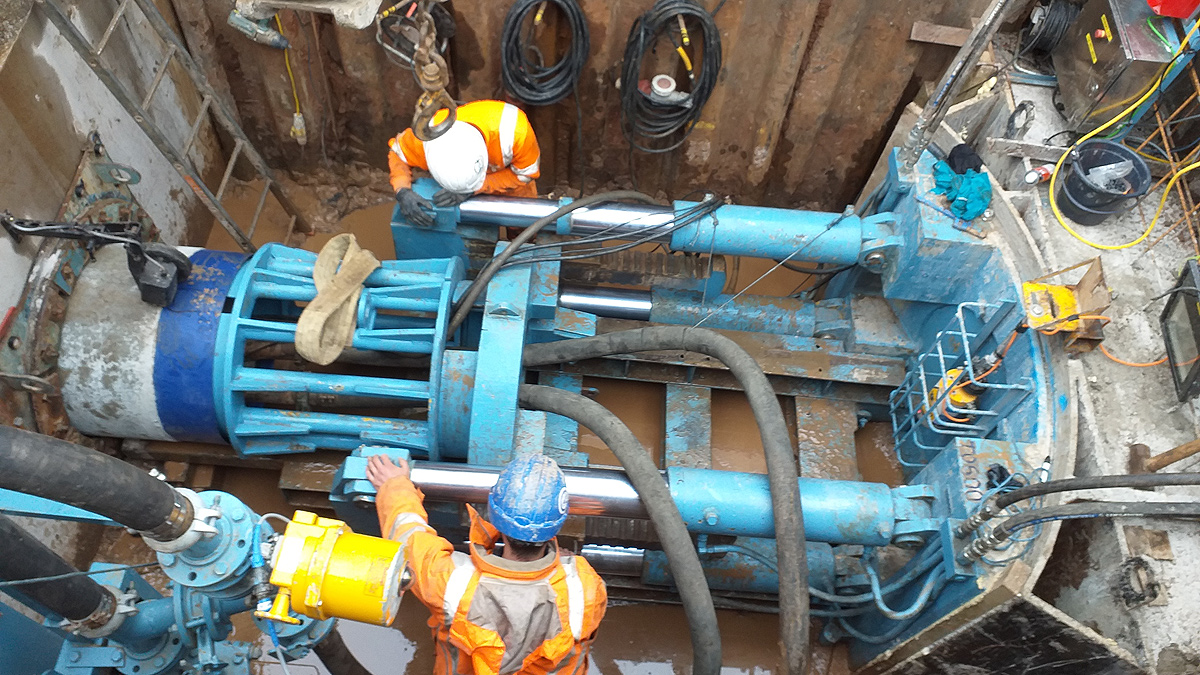
Tunnelling launch pit – Courtesy of AG Wilson
However, at approximately 60m noticeable ground heaving was experienced on the surface and deposits were reduced. A jetting crew was brought in to blow out and clear the lines. Tunnelling continued for a further 5m before a further blockage caused a stoppage. Clear timber deposits were found in the skip on the surface and a strong smell of creosote was detected. Due to the location of the works, it was concluded that either a railway sleeper or telegraph pole had caused this blockage. The temporary works designer prepared a solution to excavate and remove the blockage. Translink approved the RAMS quickly, ensuring delay was limited to only two days and the machine continue tunnelling once backfilled.
The TBM reached the reception pit within the 100mm tolerance and was retrieved using a 20T excavator located at the end of Maryville Avenue.
With tunnelling works complete, each end of the 80-metre tunnel was connected to the existing pipeline. A manhole was constructed at the mid-point of the new sewer to provide access to the existing foul and storm sewers serving the apartments at Maryville Court.
Associated work included re-lining of 100m of a 375mm sewer between Maryville Avenue and Charleville Avenue with UV lining. Also, construction of a manhole and re-benching at Great Northern Street.
The working area between the rear of Marlborough Court and the rail line was reinstated with planting and railway ballast placement. The temporary ramp from the M&S site was removed and the retaining wall and boundary sheet fence reinstated prior to removing the timber hoarding.
As agreed with M&S, reinstatement of the yard was complete by November 2020 to facilitate installation of refrigerated storage containers required for Christmas trade.
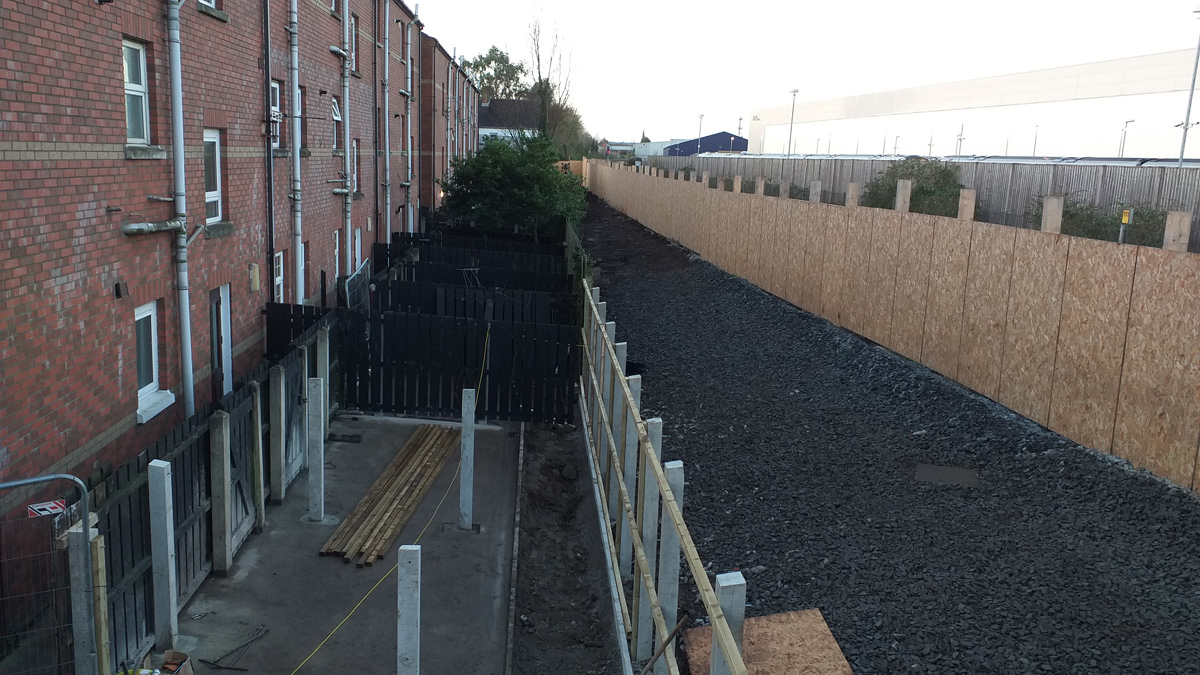
Reinstatement prior to removal of hoarding – Courtesy of AG Wilson
Health & safety
Any construction work in close proximity to a high speed rail line will have specific risks and hazards. RAMS were agreed with Translink and all work was subject to strict Track Safety Coordinator (TSC) rules. All members of the team required Track Visitor Passes (TVPs) to allow access to the rail line and full PPE was utilised at all times.
Furthermore, the project team had to ensure successful delivery of this project in the midst of the Covid-19 pandemic. Site procedures and methodologies were implemented to ensure the safety of the workforce and the general public. This included extra welfare facilities to ensure social distancing could be maintained, as well as staggered tea breaks and the supply of hand gel and face masks.
Maryville Avenue, Belfast, Flood Alleviation Project: Supply chain – key participants
- Main contractor: AG Wilson
- Design & project management: McAdam
- Flooding appraisal: Atkins
- Temporary works design: MEA Consultants
- Alignment between launch and reception pits: Clifford & Gregg Surveyors
- Tunnelling contractor: B&W Tunnelling Ltd

Stakeholder engagement
As with all construction projects in public areas, stakeholder and customer engagement is key to delivering a successful outcome. A Stakeholder Management Plan was developed during the planning stage of the project and this identified local residents, elected representatives and local businesses as priority groups for communicating with.
A public consultation meeting was held in a local community hall well in advance of the works (pre-pandemic) where representatives of the client, consultant and contractor were available to discuss the planned works and to address specific concerns and needs. This proved very beneficial, and local buy-in helped greatly with project delivery.
The local M&S store leased part of their deliver yard to be used for storing containers, control cabin, separator, generators and skips, as well as providing access to the working area. Daily food deliveries to the store (up to three per day) meant that deliveries of pipes and removal of spoil had to be carefully co-ordinated. Also, the very restricted space within the M&S yard had to accommodate the turning circle for articulated lorries. Regular consultation with M&S management and staff ensured that there were no delivery delays or disruption to the store.
Working space was also required at the rear of the apartments at Marlborough Court, including construction of ramp to access the 2.6m level differences. This required consultation with private property owners, NI Housing Executive and tenants.
Consultation with Belfast City Council and Department for Infrastructure secured two spaces in the Charleville Avenue car park, to facilitate the installation of welfare units. Further liaison took place with Belfast City Council Environmental Health Team to monitor impact of noise from night-time working throughout the construction phase. Local residents were kept informed by regular letter-drops. A customer liaison officer was available to address specific concerns.
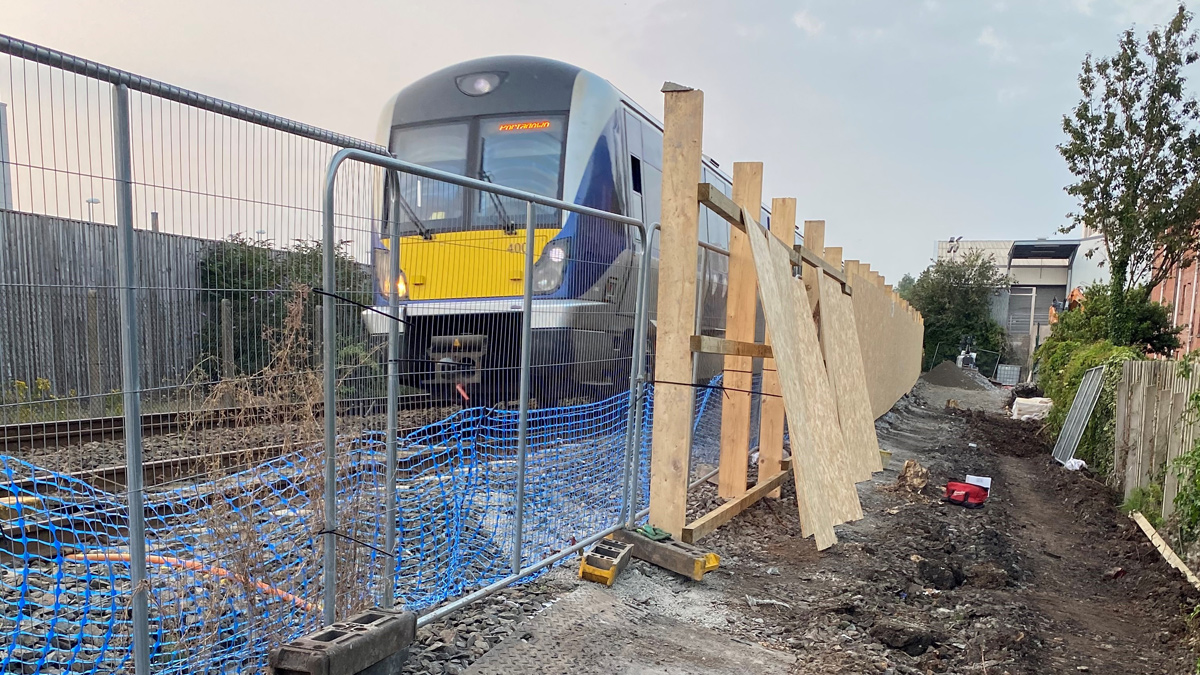
Work area adjacent to Belfast – Dublin rail line – Courtesy of AG Wilson
Conclusion
Successful delivery of this solution to reduce the risk of out-of-sewer flooding and protect the environment required careful planning and coordination from the entire project team to minimise disruption and inconvenience to the local community.





